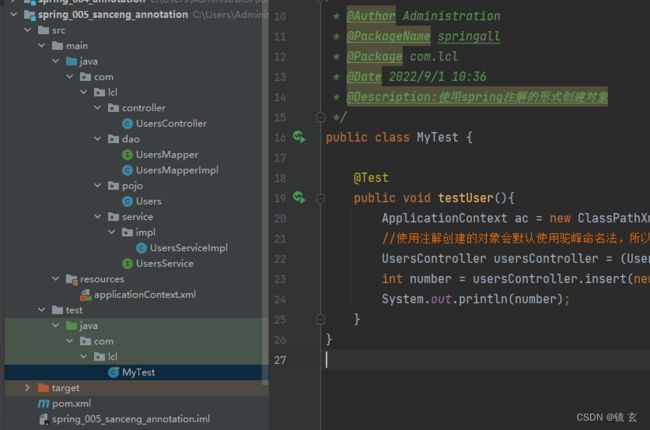- 云服务器linux下配置springboot项目启动、停止、重启脚本
努力的Andy
脚本linux运维服务器
目录为什么要配置启动脚本?配置脚本一、选择一个文件夹新建一个XXX.sh文件(xxx可以命名为项目名称,新建.sh.conf等文件用到的是vi指令)二、进入如下页面,按下键盘i键进入insert模式三、insert如下配置(只需修改APP_NAME内容为自己想要启动的jar包)四、脚本代码解释:linux下脚本测试1、启动测试2、查看状态3、停止测试4、重启测试为什么要配置启动脚本?一般情况下我们
- 本地锁 vs 分布式锁详解
重生之我在成电转码
java系统锁分布式锁
一、什么是本地锁?本地锁(LocalLock)指的是单机环境下使用Java/JVM自带的锁机制,实现线程之间的互斥和同步。✅本地锁的常见实现:锁类型说明synchronizedJVM内置,修饰方法或代码块,重量级锁,自动释放ReentrantLockJUC提供,支持可重入、可中断、公平锁、Condition等StampedLock支持读写锁和乐观读,适合读多写少场景ReadWriteLock读写分
- 【Apache Tomcat信息泄露漏洞】
猫饭_ACE
业务所需tomcatapachejava
一、漏洞详情ApacheTomcat是一个流行的开源Web服务器和Java代码的Servlet容器。9月28日,Apache发布安全公告,公开披露了Tomcat中的一个信息泄露漏洞(CVE-2021-43980)。由于某些Tomcat版本中的阻塞式读写的简化实现导致存在并发错误(极难触发),可能使客户端连接共享一个Http11Processor实例,导致响应或部分响应被错误的客户端接收,造成信息泄
- springboot 项目linux启停脚本
lovecode2011
linux运维服务器
shutdown.shjps-lvm|grepxxx|awk'{print$1}'|xargskill-15xxx-进程号或项目名称(或名称关键字)startup.shls|grep"xxx"|grep-iv"bak"|tail-n1|xargs-n1-l{}nohupjava-jar{}-Dspring.config.location=/xxx/xxx/config/application-de
- java面试题,什么是动态代理?、动态代理和静态代理有什么区别?说一下反射机制?JDK Proxy 和 CGLib 有什么区别?动态代理的底层
述雾学java
java开发语言java面试题反射java核心基础
什么是动态代理?动态代理是在程序运行期,动态的创建目标对象的代理对象,并对目标对象中的方法进行功能性增强的一种技术。在生成代理对象的过程中,目标对象不变,代理对象中的方法是目标对象方法的增强方法。可以理解为运行期间,对象中方法的动态拦截,在拦截方法的前后执行功能操作。动态代理的常见使用场景有:统计每个api的请求耗时;统一的日志输出;校验被调用的api是否已经登录和权限鉴定;SpringAOP。动
- 网络编程、URI和URL的区别、TCP/IP协议、IP和端口、URLConnection
述雾学java
Java核心基础tcp/ipjavajava基础网络编程
DAY12.1Java核心基础网络编程在互联网时代,网络在生活中处处可见,javaWeb占据了很大一部分那如何实现javaWeb编程呢?Web编程就是运行在同一个网络下面的终端,使得它们之间可以进行数据传输计算机网络基本知识计算机网络是通过硬件设施,传输媒介把不同物理地址上的计算机网络进行连接,形成一个资源共享和数据传输的网络系统两台终端进行连接需要遵守规定的网络协议语法:数据信息的结构语义:描述
- Rasa Webchat:开源聊天机器人组件
乌昱有Melanie
RasaWebchat:开源聊天机器人组件rasa-webchatAfeature-richchatwidgetforRasaandBotfront项目地址:https://gitcode.com/gh_mirrors/ra/rasa-webchatRasaWebchat是一个开源项目,旨在为Rasa或Botfront开发的虚拟助手提供在任意网站上部署的聊天窗口组件。该项目主要使用JavaScri
- ESP32学习 -从STM32工程架构进阶到ESP32架构
古希腊掌握嵌入式的神
学习stm32架构esp32
ESP32与STM32项目文件结构对比解析以下是对你提供的ESP32项目文件结构的详细解释,并与STM32(以STM32CubeIDE为例)的常见结构进行对比,帮助你理解两者的差异:1.ESP32项目文件解析文件/目录作用STM32对应或差异settingsIDE(如VSCode或Eclipse)的用户配置文件,存储个性化设置。STM32CubeIDE中类似配置存储在.settings目录或IDE
- 贪心算法(10)(java)跳跃游戏
奋进的小暄
贪心算法java游戏
题目:给定一个长度为n的0索引整数数组nums。初始位置为nums[0]。每个元素nums[i]表示从索引i向前跳转的最大长度。换句话说,如果你在nums[i]处,你可以跳转到任意nums[i+j]处:1.0=n-1)//判断是否以经跳到最后一个位置{returnret;}for(inti=left;i<=right;i++)//更新下一层最右端点{maxPos=Math.max(maxPos,n
- oceanbase 是不是架构比较复杂 和mysql对比分析
hxsln11
金融数据库oceanbase架构mysql
我先来分析用户的需求。用户的问题是关于OceanBase和MySQL的架构复杂度对比,并希望了解两者在架构上的具体差异。这是一个技术性较强的问题,用户可能是数据库开发者、架构师或者对分布式数据库感兴趣的学习者。结合上下文,用户之前已经提到过OceanBase的学习曲线较陡峭,可能是因为其分布式架构的复杂性,所以这次的问题很可能是想进一步明确OceanBase和MySQL在架构上的具体差异,以及为什
- 编写脚本在Linux下启动、停止SpringBoot工程
流烟默
系统运维Linux全面入门linuxspringbootshell
【1】启动命令nohupjava-jaryour-application.jar>/dev/null2>&1&>/dev/null2>&1:这条命令将标准输出和标准错误都重定向到/dev/null,这意味着它们不会输出到控制台或任何文件。这样做是因为我们希望所有日志都由Logback处理并写入到配置文件中指定的日志文件里。然而,如果你想要保留控制台输出(例如,对于调试目的),你可以省略这部分重定向
- 云原生技术的风口来了!!
Real Man★
云原生
云原生技术(Cloud-NativeTechnologies)是一种基于云计算架构设计和运行应用程序的方法,旨在充分利用云计算的弹性、可扩展性和敏捷性。它的核心思想是通过容器化、微服务、DevOps和持续交付等技术,构建高效、可靠且易于维护的应用系统。未来,云原生技术将继续演进,成为企业数字化转型的核心驱动力。云原生技术的核心组件容器化(Containerization):使用容器(如Docker
- Java类文档化:使用Javadoc注释
AR新视野
Javadoc文档化类方法数据成员
Java类文档化:使用Javadoc注释背景简介在软件开发过程中,代码的可读性和可维护性是至关重要的。为了帮助其他开发者更好地理解代码的用途和使用方式,编写清晰的文档是非常必要的。在Java中,Javadoc注释提供了一种标准的方式来记录和生成类、方法和数据成员的文档。使用Javadoc注释进行类文档化在Java中,有三种风格的注释,分别是单行注释、多行注释和Javadoc注释。Javadoc注释
- Java编程:从入门到实践
AR新视野
JavaScanner类分隔符增量开发字符串操作
背景简介本文将深入探讨Java编程中的标准类使用,特别是Scanner类的实用性和灵活性。通过实例和代码分析,我们将展示如何更有效地使用Scanner类进行用户输入处理,以及如何通过设置分隔符来接收用户输入的完整数据。此外,文章还将介绍增量开发技术在软件开发中的应用,并通过一个简单的Java程序实例,讨论如何设计和实现程序,以及如何在开发过程中考虑到用户体验。使用Scanner类获取用户输入Jav
- AI-智能体
修炼十万年的狗尾巴草
人工智能大数据
什么是AI智能体?「AI智能体」这个术语并没有真正被定义,对智能体究竟是什么也存在很多的争议。AI智能体可以定义为「一个被赋予行动能力的LLM(通常在RAG环境中进行函数调用),以便在环境中对如何执行任务做出高层次的决策。」当前,构建AI智能体主要有以下两种架构方法:**单一智能体:**一个大型模型处理整个任务,并基于其全面的上下文理解做出所有决策和行动。这种方法利用了大型模型的涌现能力,避免了将
- Java 双亲委派模型(Parent Delegation Model)
重生之我在成电转码
java开发语言jvm
一、什么是双亲委派模型?双亲委派模型是Java类加载器(ClassLoader)的一种设计机制:✅避免重复加载✅保证核心类安全、避免被篡改✅提高类加载效率核心思想:类加载请求从子加载器逐级向上委托父加载器,只有父加载器加载失败(ClassNotFoundException)后,子加载器才会尝试自己加载。二、双亲委派的加载流程(核心)当某个类加载器接收到类加载请求时:1️⃣先检查自己是否加载过(缓存
- java基础--序列化与反序列化的概念是什么?
阿硕的技术时间
【学习笔记】java开发语言
经典总结序列化就是把Java对象变成一串字节流,字节流就像是一种“通用语言”,可以在不同的计算机间传递。这样做的主要目的是保存对象的状态,以便以后可以恢复。反序列化则是把这些字节流重新变回Java对象,恢复对象的状态,方便程序继续使用它。详情内容1.什么是序列化?序列化是将Java对象转换为字节流的过程。字节流是一个平台无关的格式,可以在不同的计算机系统间传输。序列化的主要目的是将对象的状态保存下
- 蓝桥每日打卡--区间移位
xxjiaz
算法蓝桥杯数据结构java
#蓝桥#JAVA#区间移位题目描述数轴上有n个闭区间:D1,⋯Dn。其中区间Di用一对整数[ai,bi]来描述,满足ai≤bi。已知这些区间的长度之和至少有。所以,通过适当的移动这些区间,你总可以使得他们的"并"覆盖[0,],也就是说[0,]这个区间内的每一个点都落于至少一个区间内。你希望找一个移动方法,使得位移差最大的那个区间的位移量最小。具体来说,假设你将Di移动到[ai+ci,bi+ci]这
- 【AI 天才研究院】从 MoE 架构到 AGI:DeepSeek 将给未来带来哪些影响?
AI天才研究院
DeepSeekR1&大数据AI人工智能大模型人工智能架构agiDeepSeek
关键技术创新DeepSeek的成本优势主要源于以下几个方面的技术创新:混合专家(MoE)架构:通过选择性激活特定专家网络,大幅降低了计算成本。具体而言,DeepSeekMoE架构实现了:仅用大约40%的计算量,便达到了与LLaMA2-7B差不多的效果。这种选择性激活的方式大大提高了模型的参数效率,从而在保持高性能的同时,也能在计算资源的使用上保持高效。FP8低精度训练:DeepSeek采用了FP8
- Android的Camera架构介绍
live123
androidAndroidJNIUIC#C++
第一部分Camera概述Android的Camera包含取景器(viewfinder)和拍摄照片的功能。目前Android发布版的Camera程序虽然功能比较简单,但是其程序的架构分成客户端和服务器两个部分,它们建立在Android的进程间通讯Binder的结构上。以开源的Android为例,Camera的代码主要在以下的目录中:Camera的JAVA程序的路径:packages/apps/Cam
- 后端框架模块化
GIS程序媛—椰子
后端
后端框架的模块化设计旨在简化开发流程、提高可维护性,并通过分层解耦降低复杂性。以下是常见的后端模块及其在不同语言(Node.js、Java、Python)中的实现方式:目录1.路由(Routing)2.中间件(Middleware)3.数据库与ORM(models)4.迁移(Migration)5.服务层(ServiceLayer)6.配置管理(Configuration)7.依赖注入(DI)8.
- 9种JavaScript数组去重的高阶方法
2501_90226133
javascriptjava算法
给定一个数组[1,2,2,4,null,null,‘3’,‘abc’,3,5,4,1,2,2,4,null,null,‘3’,‘abc’,3,5,4]去除重复项。letarr=[1,2,2,4,null,null,‘3’,‘abc’,3,5,4,1,2,2,4,null,null,‘3’,‘abc’,3,5,4]1、利用对象的key唯一众所周知,对象的key不可重复,否则后者将覆盖前者。利用该特性
- C++和Java相比,哪个更适合初学者学习?
c++java
C++和Java都是非常流行的编程语言,但它们在设计理念、应用场景和学习难度上存在显著差异。对于初学者来说,选择哪种语言更适合,取决于学习目标、兴趣和未来的职业规划。以下是对C++和Java的详细对比,帮助初学者做出选择:一、学习难度C++复杂性高:C++继承了C语言的复杂性,支持多种编程范式(如面向对象、泛型编程等),语法复杂,学习曲线陡峭。内存管理:C++需要手动管理内存,容易出现内存泄漏和悬
- Ark-TS 语言:鸿蒙生态的高效开发利器,让我们用大白话说一说
harmonyos-next
Ark-TS(华为专门为鸿蒙系统——就是华为自己的手机、平板、智能设备操作系统——设计的编程语言,基于TypeScript,一种比普通JavaScript更严格、能减少错误的语言)是鸿蒙应用开发的主力工具。它就像给开发者配备了一套趁手的工具包,让写代码又快又稳。简单来说,Ark-TS有几个厉害的地方:静态类型检查(写代码时必须给变量指定类型,比如数字、文字,这样电脑能在运行前就发现类型错误,避免程
- Android Camera 架构
2501_90226133
android架构
二、CameraApp层简述三、CameraFramework层简述四、CameraHal3子系统五、下面需要梳理的重点-正在进行一.AndroidCamera整体架构简述自Android8.0之后大多机型采用CameraAPI2HAL3架构,先盗改谷歌的一张图,读完整部代码后再看这张图,真的是很清晰,很简洁,很到位.原图:https://source.android.google.cn/devi
- HarmonyOS 5 开发环境介绍
harmonyos-next
一、HarmonyOS5是什么?HarmonyOS5是华为推出的新一代分布式操作系统,基于微内核架构,专注于鸿蒙原生应用开发,不再兼容安卓APK。其核心目标是通过"一次开发、多端部署"的能力,实现全场景设备(手机、平板、智能穿戴、车机、智能家居等)的无缝协同。核心特性包括:分布式架构:设备间可自由组网,共享算力与资源;高性能内核:基于开源鸿蒙(OpenHarmony)优化,支持64位ARM、x86
- 适合阅读源码的 Java 优质开源框架、库盘点(初级友好项目、中级进阶项目、高级深入项目)
我命由我12345
Java-项目java开源开发语言java-eespringbootspringintellij-idea
一、初级友好项目1、JUnit5基本介绍:JUnit5是单元测试框架,代码简洁,适合学习测试驱动开发(TDD)和设计模式GitHub地址:https://github.com/junit-team/junit5特点:代码量适中,模块化设计,适合学习测试框架的实现原理2、Guava基本介绍:Guava是Google核心库,包含集合、缓存、字符串处理等工具类GitHub地址:https://githu
- 单例模式实现
后端
一、是什么单例模式(SingletonPattern):创建型模式,提供了一种创建对象的最佳方式,这种模式涉及到一个单一的类,该类负责创建自己的对象,同时确保只有单个对象被创建在应用程序运行期间,单例模式只会在全局作用域下创建一次实例对象,让所有需要调用的地方都共享这一单例对象,如下图所示:二、实现在javascript中,实现一个单例模式可以用一个变量来标志当前的类已经创建过对象,如果下次获取当
- 收入突破 5 万,从大专生到大模型开发-第二篇(下)
智码工坊
AI编程程序人生
第二篇下:实战案例拆解——我用AI干掉80%重复工作大家好,我是明聪,98年逆袭的大模型研发工程师,前Java转型幸存者,湖北荆州人,毕业武汉某职校。学习心得:突出“普通人破局”的真实挣扎深夜破防:我也想过放弃1:学RAG时,连续3天卡在向量数据库检索效果,甚至想“回去干Java算了”。直到发现LangChain-Chatchat开源项目,直接套用现成框架,才重拾信心。2:第一次面试被质疑“半路出
- Java高级技术
星星不打輰
Javajava开发语言
Java高级技术单元测试:Junit单元测试框架针对于最小的功能单元:方法,编写测试代码对于其进行正确性测试自动测试全部方法样例:packagejunittest;publicclassStringUtil{publicstaticintgetLength(Stringstr){if(str==null||"".equals(str)){return-1;}returnstr.length();}
- C/C++Win32编程基础详解视频下载
择善Zach
编程C++Win32
课题视频:C/C++Win32编程基础详解
视频知识:win32窗口的创建
windows事件机制
主讲:择善Uncle老师
学习交流群:386620625
验证码:625
--
- Guava Cache使用笔记
bylijinnan
javaguavacache
1.Guava Cache的get/getIfPresent方法当参数为null时会抛空指针异常
我刚开始使用时还以为Guava Cache跟HashMap一样,get(null)返回null。
实际上Guava整体设计思想就是拒绝null的,很多地方都会执行com.google.common.base.Preconditions.checkNotNull的检查。
2.Guava
- 解决ora-01652无法通过128(在temp表空间中)
0624chenhong
oracle
解决ora-01652无法通过128(在temp表空间中)扩展temp段的过程
一个sql语句后,大约花了10分钟,好不容易有一个结果,但是报了一个ora-01652错误,查阅了oracle的错误代码说明:意思是指temp表空间无法自动扩展temp段。这种问题一般有两种原因:一是临时表空间空间太小,二是不能自动扩展。
分析过程:
既然是temp表空间有问题,那当
- Struct在jsp标签
不懂事的小屁孩
struct
非UI标签介绍:
控制类标签:
1:程序流程控制标签 if elseif else
<s:if test="isUsed">
<span class="label label-success">True</span>
</
- 按对象属性排序
换个号韩国红果果
JavaScript对象排序
利用JavaScript进行对象排序,根据用户的年龄排序展示
<script>
var bob={
name;bob,
age:30
}
var peter={
name;peter,
age:30
}
var amy={
name;amy,
age:24
}
var mike={
name;mike,
age:29
}
var john={
- 大数据分析让个性化的客户体验不再遥远
蓝儿唯美
数据分析
顾客通过多种渠道制造大量数据,企业则热衷于利用这些信息来实现更为个性化的体验。
分析公司Gartner表示,高级分析会成为客户服务的关键,但是大数据分析的采用目前仅局限于不到一成的企业。 挑战在于企业还在努力适应结构化数据,疲于根据自身的客户关系管理(CRM)系统部署有效的分析框架,以及集成不同的内外部信息源。
然而,面对顾客通过数字技术参与而产生的快速变化的信息,企业需要及时作出反应。要想实
- java笔记4
a-john
java
操作符
1,使用java操作符
操作符接受一个或多个参数,并生成一个新值。参数的形式与普通的方法调用不用,但是效果是相同的。加号和一元的正号(+)、减号和一元的负号(-)、乘号(*)、除号(/)以及赋值号(=)的用法与其他编程语言类似。
操作符作用于操作数,生成一个新值。另外,有些操作符可能会改变操作数自身的
- 从裸机编程到嵌入式Linux编程思想的转变------分而治之:驱动和应用程序
aijuans
嵌入式学习
笔者学习嵌入式Linux也有一段时间了,很奇怪的是很多书讲驱动编程方面的知识,也有很多书将ARM9方面的知识,但是从以前51形式的(对寄存器直接操作,初始化芯片的功能模块)编程方法,和思维模式,变换为基于Linux操作系统编程,讲这个思想转变的书几乎没有,让初学者走了很多弯路,撞了很多难墙。
笔者因此写上自己的学习心得,希望能给和我一样转变
- 在springmvc中解决FastJson循环引用的问题
asialee
循环引用fastjson
我们先来看一个例子:
package com.elong.bms;
import java.io.OutputStream;
import java.util.HashMap;
import java.util.Map;
import co
- ArrayAdapter和SimpleAdapter技术总结
百合不是茶
androidSimpleAdapterArrayAdapter高级组件基础
ArrayAdapter比较简单,但它只能用于显示文字。而SimpleAdapter则有很强的扩展性,可以自定义出各种效果
ArrayAdapter;的数据可以是数组或者是队列
// 获得下拉框对象
AutoCompleteTextView textview = (AutoCompleteTextView) this
- 九封信
bijian1013
人生励志
有时候,莫名的心情不好,不想和任何人说话,只想一个人静静的发呆。有时候,想一个人躲起来脆弱,不愿别人看到自己的伤口。有时候,走过熟悉的街角,看到熟悉的背影,突然想起一个人的脸。有时候,发现自己一夜之间就长大了。 2014,写给人
- Linux下安装MySQL Web 管理工具phpMyAdmin
sunjing
PHPInstallphpMyAdmin
PHP http://php.net/
phpMyAdmin http://www.phpmyadmin.net
Error compiling PHP on CentOS x64
一、安装Apache
请参阅http://billben.iteye.com/admin/blogs/1985244
二、安装依赖包
sudo yum install gd
- 分布式系统理论
bit1129
分布式
FLP
One famous theory in distributed computing, known as FLP after the authors Fischer, Lynch, and Patterson, proved that in a distributed system with asynchronous communication and process crashes,
- ssh2整合(spring+struts2+hibernate)-附源码
白糖_
eclipsespringHibernatemysql项目管理
最近抽空又整理了一套ssh2框架,主要使用的技术如下:
spring做容器,管理了三层(dao,service,actioin)的对象
struts2实现与页面交互(MVC),自己做了一个异常拦截器,能拦截Action层抛出的异常
hibernate与数据库交互
BoneCp数据库连接池,据说比其它数据库连接池快20倍,仅仅是据说
MySql数据库
项目用eclipse
- treetable bug记录
braveCS
table
// 插入子节点删除再插入时不能正常显示。修改:
//不知改后有没有错,先做个备忘
Tree.prototype.removeNode = function(node) {
// Recursively remove all descendants of +node+
this.unloadBranch(node);
// Remove
- 编程之美-电话号码对应英语单词
bylijinnan
java算法编程之美
import java.util.Arrays;
public class NumberToWord {
/**
* 编程之美 电话号码对应英语单词
* 题目:
* 手机上的拨号盘,每个数字都对应一些字母,比如2对应ABC,3对应DEF.........,8对应TUV,9对应WXYZ,
* 要求对一段数字,输出其代表的所有可能的字母组合
- jquery ajax读书笔记
chengxuyuancsdn
jQuery ajax
1、jsp页面
<%@ page language="java" import="java.util.*" pageEncoding="GBK"%>
<%
String path = request.getContextPath();
String basePath = request.getScheme()
- JWFD工作流拓扑结构解析伪码描述算法
comsci
数据结构算法工作活动J#
对工作流拓扑结构解析感兴趣的朋友可以下载附件,或者下载JWFD的全部代码进行分析
/* 流程图拓扑结构解析伪码描述算法
public java.util.ArrayList DFS(String graphid, String stepid, int j)
- oracle I/O 从属进程
daizj
oracle
I/O 从属进程
I/O从属进程用于为不支持异步I/O的系统或设备模拟异步I/O.例如,磁带设备(相当慢)就不支持异步I/O.通过使用I/O 从属进程,可以让磁带机模仿通常只为磁盘驱动器提供的功能。就好像支持真正的异步I/O 一样,写设备的进程(调用者)会收集大量数据,并交由写入器写出。数据成功地写出时,写入器(此时写入器是I/O 从属进程,而不是操作系统)会通知原来的调用者,调用者则会
- 高级排序:希尔排序
dieslrae
希尔排序
public void shellSort(int[] array){
int limit = 1;
int temp;
int index;
while(limit <= array.length/3){
limit = limit * 3 + 1;
- 初二下学期难记忆单词
dcj3sjt126com
englishword
kitchen 厨房
cupboard 厨柜
salt 盐
sugar 糖
oil 油
fork 叉;餐叉
spoon 匙;调羹
chopsticks 筷子
cabbage 卷心菜;洋白菜
soup 汤
Italian 意大利的
Indian 印度的
workplace 工作场所
even 甚至;更
Italy 意大利
laugh 笑
m
- Go语言使用MySQL数据库进行增删改查
dcj3sjt126com
mysql
目前Internet上流行的网站构架方式是LAMP,其中的M即MySQL, 作为数据库,MySQL以免费、开源、使用方便为优势成为了很多Web开发的后端数据库存储引擎。MySQL驱动Go中支持MySQL的驱动目前比较多,有如下几种,有些是支持database/sql标准,而有些是采用了自己的实现接口,常用的有如下几种:
http://code.google.c...o-mysql-dri
- git命令
shuizhaosi888
git
---------------设置全局用户名:
git config --global user.name "HanShuliang" //设置用户名
git config --global user.email "
[email protected]" //设置邮箱
---------------查看环境配置
git config --li
- qemu-kvm 网络 nat模式 (四)
haoningabc
kvmqemu
qemu-ifup-NAT
#!/bin/bash
BRIDGE=virbr0
NETWORK=192.168.122.0
GATEWAY=192.168.122.1
NETMASK=255.255.255.0
DHCPRANGE=192.168.122.2,192.168.122.254
TFTPROOT=
BOOTP=
function check_bridge()
- 不要让未来的你,讨厌现在的自己
jingjing0907
生活 奋斗 工作 梦想
故事one
23岁,他大学毕业,放弃了父母安排的稳定工作,独闯京城,在家小公司混个小职位,工作还算顺手,月薪三千,混了混,混走了一年的光阴。 24岁,有了女朋友,从二环12人的集体宿舍搬到香山民居,一间平房,二人世界,爱爱爱。偶然约三朋四友,打扑克搓麻将,日子快乐似神仙; 25岁,出了几次差,调了两次岗,薪水涨了不过百,生猛狂飙的物价让现实血淋淋,无力为心爱银儿购件大牌
- 枚举类型详解
一路欢笑一路走
enum枚举详解enumsetenumMap
枚举类型详解
一.Enum详解
1.1枚举类型的介绍
JDK1.5加入了一个全新的类型的”类”—枚举类型,为此JDK1.5引入了一个新的关键字enum,我们可以这样定义一个枚举类型。
Demo:一个最简单的枚举类
public enum ColorType {
RED
- 第11章 动画效果(上)
onestopweb
动画
index.html
<!DOCTYPE html PUBLIC "-//W3C//DTD XHTML 1.0 Transitional//EN" "http://www.w3.org/TR/xhtml1/DTD/xhtml1-transitional.dtd">
<html xmlns="http://www.w3.org/
- Eclipse中jsp、js文件编辑时,卡死现象解决汇总
ljf_home
eclipsejsp卡死js卡死
使用Eclipse编辑jsp、js文件时,经常出现卡死现象,在网上百度了N次,经过N次优化调整后,卡死现象逐步好转,具体那个方法起到作用,不太好讲。将所有用过的方法罗列如下:
1、取消验证
windows–>perferences–>validation
把 除了manual 下面的全部点掉,build下只留 classpath dependency Valida
- MySQL编程中的6个重要的实用技巧
tomcat_oracle
mysql
每一行命令都是用分号(;)作为结束
对于MySQL,第一件你必须牢记的是它的每一行命令都是用分号(;)作为结束的,但当一行MySQL被插入在PHP代码中时,最好把后面的分号省略掉,例如:
mysql_query("INSERT INTO tablename(first_name,last_name)VALUES('$first_name',$last_name')");
- zoj 3820 Building Fire Stations(二分+bfs)
阿尔萨斯
Build
题目链接:zoj 3820 Building Fire Stations
题目大意:给定一棵树,选取两个建立加油站,问说所有点距离加油站距离的最大值的最小值是多少,并且任意输出一种建立加油站的方式。
解题思路:二分距离判断,判断函数的复杂度是o(n),这样的复杂度应该是o(nlogn),即使常数系数偏大,但是居然跑了4.5s,也是醉了。 判断函数里面做了3次bfs,但是每次bfs节点最多
